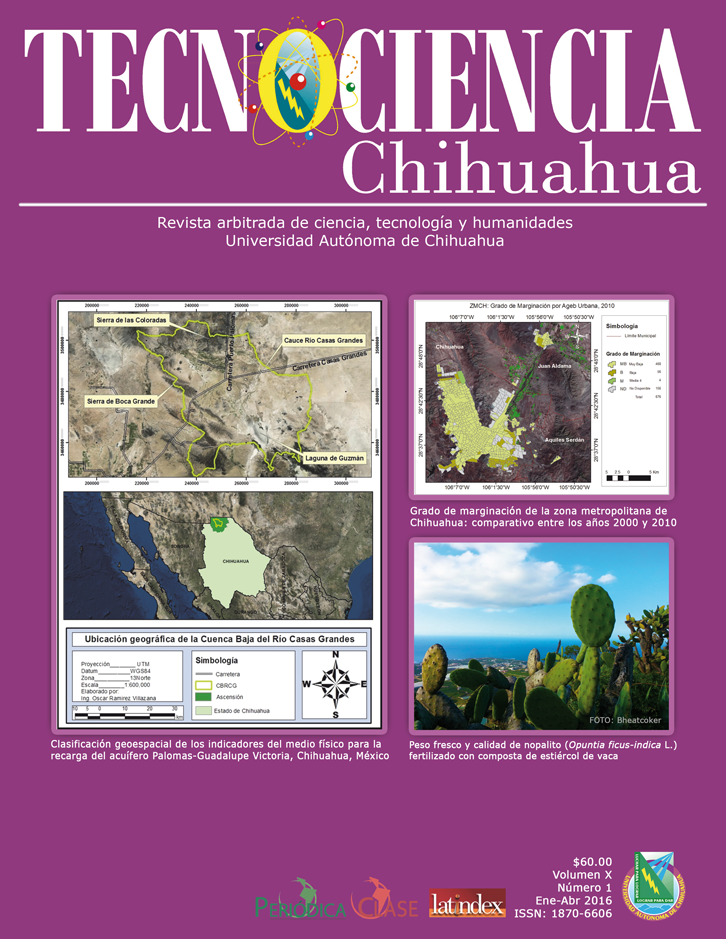Grado de marginación de la zona metropolitana de Chihuahua: un comparativo entre el año 2000 y el 2010
Degree of marginalization of the metropolitan area of Chihuahua: a comparative between 2000 and 2010
Resumen
El objetivo del presente trabajo fue realizar un análisis comparativo entre el año 2000 y el 2010 del grado de marginación urbana de la Zona Metropolitana de Chihuahua desde una perspectiva local. Para la estimación del índice de marginación urbana se consideró como fuente de información los censos generales de población y vivienda de 2000 y de 2010, debido a que cuentan con la cobertura, grado de desagregación y actualidad de los datos necesarios para la construcción del índice a escala de Área Geoestadística Básica (AGEB) urbanas. Se decidió homogenizar diez indicadores en las categorías Salud, Educación, Vivienda y Bienes. De las cinco categorías definidas Muy Baja, Baja, Media, Alta y Muy Alta marginación; la que presentó mayor porcentaje fue la de Muy Baja marginación con un 70.75%, equivalente a 300 AGEB urbanas de las 424 definidas para el año 2000 y del 68.05%, equivalente a 460 AGEB urbanas de las 676 definidas para el año 2010. El análisis comparativo mostró un comportamiento estable en el grado de marginación del periodo estudiado, también permitió determinar que muy bajo porcentaje de la población reside en AGEB con grandes privaciones en salud, educación, vivienda y bienes.
Abstract
The aim of this study was to conduct a comparative analysis between 2000 and 2010 the degree of urban marginalization of the metropolitan area of Chihuahua from a local perspective. To estimate the rate of urban marginalization was considered as a source of information the General Census of Population and Housing 2000 and 2010, due they have the coverage, degree of disaggregation and timeliness of the data needed for the construction of the index scale urban census tract. It was decided to standardize ten indicators in Health, Education, Housing and Real categories. Of the five categories defined Very Low, Low, Medium, High and Very High marginalization; which presents higher percentage was the marginalization of Very Low with 70.75% equivalent to 300 of the 424 urban census tract defined for 2000 and 68.05% equivalent to 460 of the 676 urban census tract set for the year 2010. The comparative analysis showed a stable behavior in the degree of marginalization of the studied period, it also allowed us to determine that a very low percentage of the population is living in census tract with great deprivation in health, education, housing and real.
Keywords: urban marginalization index, degree of marginalization, metropolitan area
Citas
Consejo Nacional de Población. 2000. Metodología de estimación del índice de marginación urbana 2000. CONAPO. https://tinyurl.com/2cfn9c9e
Consejo Nacional de Población. 2000. Grado de marginación por AGEB urbana 2000. CONAPO. https://tinyurl.com/2jqx8ufk
Consejo Nacional de Población. 2010. Metodología de estimación del índice de marginación urbana 2010. CONAPO. https://tinyurl.com/2mad7x6c
Consejo Nacional de Población. 2010. Grado de marginación por AGEB urbana 2010. Consejo Nacional de Población. CONAPO. https://tinyurl.com/2nyszlo3
Food and Agriculture Organization of the United Nations. 2014. The state of food insecurity in the world. FAO, WFP, IFAD. https://www.fao.org/publications/sofi/2014/en/
Gatzweiler, F., H. Baumüller, C. Ladenburger & J. Von Braun. 2011. Marginality: Addressing the root causes of extreme poverty. Working Paper Series 77. ZEF Center for Development Research. University of Bonn. https://doi.org/10.2139/ssrn.2235654
Gatzweiler, F. W. & H. Baumüller. 2013. Marginality—A framework for analyzing causal complexities of poverty. En Marginality. Addressing the nexus of poverty, exclusion and ecology (pp. 27–40). Springer Dordrecht. ISBN 9789400770607. https://doi.org/10.1007/978-94-007-7061-4
ILO. 2013. Child labour. https://www.ilo.org/global/topics/child-labour/lang--en/index.htm
Instituto Nacional de Estadística y Geografía. 2000. Censo General de Población y Vivienda 2000. INEGI. https://www.inegi.org.mx/app/biblioteca/ficha.html?upc=702825006519
Instituto Nacional de Estadística y Geografía. 2000. Sistema para la Consulta de Información Censal. INEGI. https://www.inegi.org.mx/programas/ccpv/2000/
Instituto Nacional de Estadística y Geografía. 2010. Sistema para la Consulta de Información Censal. INEGI. https://www.inegi.org.mx/programas/ccpv/2010/?ps=herramientas
Instituto Nacional de Estadística y Geografía. 2010. Censo General de Población y Vivienda 2010. INEGI. https://www.inegi.org.mx/programas/ccpv/2010/
López, L.F., L. Rodríguez & M. Székely. 2004. Medición del Desarrollo en México. PNUD. México. https://sic.cultura.gob.mx/documentos/1006.pdf
Organization for Economic Cooperation & Development. 2012. World energy outlook: 2012. OECD. https://tinyurl.com/2m8te544
United Nations Procurement Division. 2012. Human development report 2011: Sustainability and equity – A better future for all. UNPD. https://tinyurl.com/2fusel37
UN-HABITAT. 2003. The challenge of slums. UN-HABITAT. https://tinyurl.com/2zou7eaf
Van Velthuizen, H. T., B. Huddleston, G. Fischer, M. Salvatore, E. Ataman, F. O. Nachtergaele, M. Zanetti & M. Bloise. 2007. Mapping biophysical factors that influence agricultural production and rural vulnerability. Environment and Natural Resources No. 11. FAO. http://www.fao.org/docrep/010/a1075e/a1075e00.htm
World Health Organization. 2010. Progress on sanitation and drinking-water: 2010 update. WHO-UNAIDS. https://tinyurl.com/2ndyzwzd
Derechos de autor 2020 TECNOCIENCIA Chihuahua

Esta obra está bajo licencia internacional Creative Commons Reconocimiento-NoComercial 4.0.







